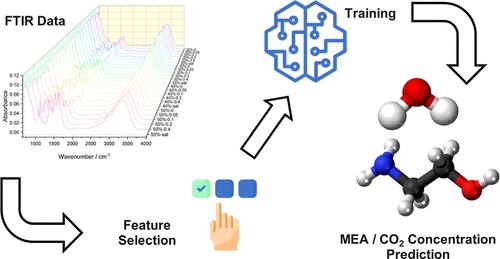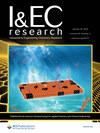用于碳捕获中高效溶剂成分分析的集成式机器学习/傅立叶变换红外框架
IF 3.8
3区 工程技术
Q2 ENGINEERING, CHEMICAL
引用次数: 0
摘要
溶剂成分分析是确定碳捕获过程性能的关键。目前的工作重点是优化样品制备、分析时间和方法可靠性。这项工作介绍了一种创新方法,它将机器学习算法与傅立叶变换红外(FTIR)光谱相结合,在训练阶段利用有限的样品数量精确定量碳捕集溶剂中的二氧化碳(CO2)和单乙醇胺(MEA)。该框架包括结合统计和领域知识分析的特征选择,以选择能准确代表 MEA 和 CO2 的适当波长。比较了 11 个机器学习模型根据先前选定的波长吸光度预测溶液中 MEA 和 CO2 浓度的准确性。结果表明,极梯度提升和自适应提升分别是预测 MEA 和 CO2 浓度的最佳模型。这项研究获得了与文献类似的准确度,数据集平均减少了 2.63 倍。该框架展示了 ML 关联和傅立叶变换红外光谱的协同潜力,为溶剂中 MEA 和 CO2 浓度的常规分析提供了一种可靠的方法。本文章由计算机程序翻译,如有差异,请以英文原文为准。

Integrated Machine Learning/FT-IR Framework for Efficient Solvent Composition Analysis in Carbon Capture
Solvent composition analysis is key to determining the performance of the carbon capture process. Current efforts focus on the optimization of sample preparation, analysis time, and method reliability. This work introduces an innovative approach that combines a machine learning algorithm with Fourier transform infrared (FTIR) spectroscopy for the precise and accurate quantification of carbon dioxide (CO2) and monoethanolamine (MEA) in carbon capture solvent with a limited number of samples in the training phase. The framework consists of feature selection that combines statistical and domain-knowledge analysis to choose the appropriate wavenumber that represents both MEA and CO2 accurately. Eleven machine learning models are compared in terms of accuracy to predict the MEA and CO2 concentration in solution given the absorbance from the previously selected wavenumber. The result shows that extreme gradient boosting and adaptive boosting are the best models for predicting MEA and CO2 concentration, respectively. This study obtained a similar accuracy compared to the literature with a data set reduced by a factor of 2.63 on average. The framework showcases the synergistic potential of ML associated and FTIR spectroscopy, offering a robust methodology for routine analysis of MEA and CO2 concentration in the solvent.
求助全文
通过发布文献求助,成功后即可免费获取论文全文。
去求助
来源期刊

Industrial & Engineering Chemistry Research
工程技术-工程:化工
CiteScore
7.40
自引率
7.10%
发文量
1467
审稿时长
2.8 months
期刊介绍:
ndustrial & Engineering Chemistry, with variations in title and format, has been published since 1909 by the American Chemical Society. Industrial & Engineering Chemistry Research is a weekly publication that reports industrial and academic research in the broad fields of applied chemistry and chemical engineering with special focus on fundamentals, processes, and products.
 求助内容:
求助内容: 应助结果提醒方式:
应助结果提醒方式:


